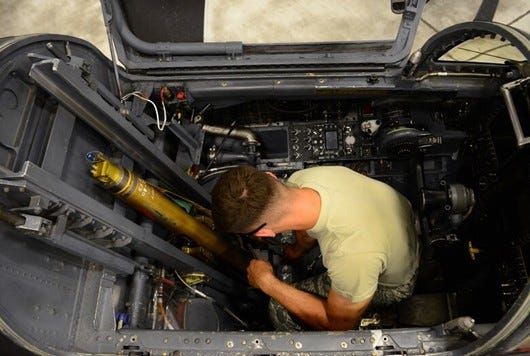Cartridge Actuated and Propellant Actuated Devices
The ammunition supply commodity encompasses many items from small caliber, medium caliber, rockets, and even air-to-surface missiles. Many of which are used by aircraft platforms during gunnery tables in training. One uncommon subcategory of ammunition supply is that of cartridge actuated, and propellant actuated devices know as CAD/PADs, used in crew escape devices, cable cutters, weapons release, and fire-suppression systems. CADs and PADs contain energetic material, including mechanical or electronic actuating components. Propellant actuated devices include systems of catapults, rocket catapults, and rocket motors used in military aircraft escape systems. Cartridge actuated devices are those that respond instantaneously and those that provide a delayed response to initiation. Anyone that has dealt with and managed the CAD/PAD items for specific aircraft knows they have a set shelf life and installation life and are a bit more complicated than routine ammunition management.
Service Limits
The CAD/PAD limits are designated as shelf life and installed life or known as service life. The shelf life, as the name implies, occurs regardless of it being in storage (on a shelf). The whole life is from the date of manufacture (DOM) to the published shelf-life limits, based on the number of months. In contrast, the installed life begins once you open the vacuum-sealed container, regardless of the reason. Whichever date comes first, either the shelf life or the service life, the item is expired and replaced except when there is a granted service-life extension. An approved extension is when engineers review performance data for a given lot and can take a week or more.
Product Descriptions/Types
In the civilian sector, complete airbags modules are considered propellant actuated devices. The use of CAD/PADs is abundant in various military aircraft with many uses within subsystems. Each CAD/PAD has a designed specific function in the aircraft or the aircraft subsystem, which includes:
Aircraft Fire Extinguisher Cartridges. These cartridges, also known as Squibs, release fire extinguishing fluid from a bottle into the area surrounding an engine or axillary power unit in the event of a fire.
Figure 1. Bell-412 Engine Fire Extinguishers Photo: forums.x-plane.org/ Dave Ed
Pyrotechnic Cutters. These cartridges use energetic materials and a cutting blade to cut line, cable, or refueling hose explosively as their designed function.
Figure 2. Space Shuttle Parachute Line Cutter Photo: worthpoint.com
Delay Cartridges. Delay cartridges perform a function with a specific time frame. In some cases, it is part of a series to perform several functions concurrently or in sequence, before crewman can escape in an emergency. Detonating Cord and Window Cutting Assemblies. The detonating cord is Flexible Confined Detonating Cord (FCDC), Shielded Mild Detonating Cord (SMDC), and the Window Cutting Assemblies (WCA) used to explosively cut the windows and doors from the canopy structure to provide a rapid means of emergency escape.
Impulse/Ejector Cartridges. These cartridges are initiated electrically, manually, or by gas pressure and used in devices utilizing pressure for their operation.
Figure 3. Installation of impulse cartridges into decoy flares. Photo: U.S. Air Force /Senior Airman Bryan Swink.
Initiators. Initiator devices are explosive devices designed to start a sequence of functions, most commonly in emergency systems.
Figure 4. AH-64 Apache Egress Training. Photo: YouTube/ bnelson313
Rocket Catapults and Rocket Motors. Rocket Catapults and Motors are explosive devices that provide an initial power for the ejection seat out of an aircraft in the event of an emergency. Thrusters. The cartridge actuated thrusters force a mechanical operation or function, providing a clear ejection path during the aircraft ejection or other emergency sequence.
Figure 5. Removal of a Catapult from a U-2 Dragon Lady. Photo: U.S. Air Force/ Senior Airman Tristan D. Viglianco.
System Component Management
The commodity of Cartridge Actuated Devices (CADs) and Propellant Actuated Devices (PADs) used by the United States military span all services. But each service has its requirements and manages in its unique way. There are joint efforts such as the Virtual Fleet Support (VFS) created by the CAD/PAD Joint Program Office to apply web-based technology and commercial practices to processes associated with the sustainment of CAD/PADs. At the same time, the Project Director Joint Bombs manages procurement funding of CAD/PAD items for Army Aircraft. The Naval Surface Warfare Center, Indian Head Explosive Ordnance Disposal Technology Division, provides the DoD engineering and acquisition agent for all Services for CAD/PAD items. Each service has to manage its CAD/PADs, but they do have joint issues.
One of the anomalies of CAD/PAD items is that they fall in-between an aircraft parts and a Class V item in addition to also being an expendable item that only gets used in an emergency. The CAD/PAD item loses its identity once installed on an aircraft, which makes the tracking of the item a maintenance procedure. At the same time requires the sustainment tracking in ammunition management to ensure replacement items are available when needed. Unlike standard ammunition in stock, ordered CAD/PAD items are only stored to replace known items that will expire. Which makes the replacement of emergency expended items a variance that no one accounts for until the supply system requires it.
Conclusion
The nuances of CAD/PADs management become more manageable with experience, and if you have a strong aviation background. But as with anything, the experience is always a teacher. The key is to understand that while you may consider CAD/PADs a Class V supply item, others may see an aircraft part that is required to get fighter jet or helicopter back to fully operational readiness. It may take a little bit of understanding and extra work from both parties, but in the end, the system will provide. Having an operational understanding of the entire fleet and identifying requirements CAD/PADs early will go a long way with the end-user. Additionally, nothing is more paramount then ensuring the safety of our aviators.






